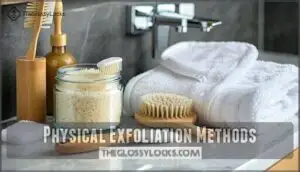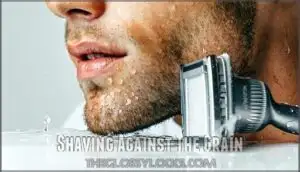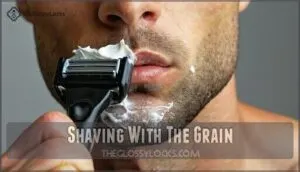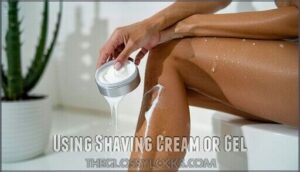This site is supported by our readers. We may earn a commission, at no cost to you, if you purchase through links.

First, sweep away dead skin cells with a gentle scrub or opt for chemical exfoliants like glycolic acid.
Imagine you’re prepping a canvas—clear away the old so the new hair can break free.
This also prevents ingrown hairs, and it turns shaving into less of a gamble.
Don’t rush; match exfoliation to your skin type.
Sensitive skin? Try an enzyme exfoliant instead.
With the right routine, you’ll get closer shaves and boost your post-shave glow.
Stick around—your skin’s next comfort move is just ahead, and mastering these techniques is key to achieving bump-free skin with a great glow.
Table Of Contents
- Key Takeaways
- Exfoliating Before Shaving
- Skin Types and Exfoliation
- Exfoliation Techniques and Methods
- Shaving and Exfoliation Best Practices
- Post-Shave Care and Maintenance
- Frequently Asked Questions (FAQs)
- Should you exfoliate before shaving?
- How do you exfoliate your skin before a shave?
- How do you exfoliate your face?
- How do I prepare my skin for a smooth shave?
- What is exfoliation and how does it work?
- Should you Soften your skin before shaving?
- How to exfoliate skin for shaving?
- Is shaving a good form of exfoliation?
- In what order should you shave and exfoliate?
- Should I exfoliate before or after shaving down there?
- Conclusion
Key Takeaways
- Always exfoliate before shaving to clear away dead skin, prevent razor bumps, and help your razor glide smoothly.
- Match your exfoliation method to your skin type—gentle enzyme exfoliants for sensitive skin, salicylic acid for oily skin, and lactic acid for dry skin.
- Prep with warm water, then use circular motions for exfoliation and rinse well before you shave for best results.
- Moisturize and protect your skin with sunscreen after shaving to lock in hydration and prevent irritation.
Exfoliating Before Shaving
Exfoliating before you shave clears away dead skin cells, so your razor glides smoothly instead of getting stuck.
Sweeping away dead skin before shaving sets your razor up for a glide, not a fight.
If you’ve ever wondered why you keep getting bumps or ingrown hairs, this simple step might be the secret your skin’s been waiting for.
Removing Dead Skin Cells
Kicking off your shave with exfoliation is like clearing the path before a road trip—dead skin cells don’t stand a chance.
Using exfoliating techniques like gentle scrubs or dermaplaning methods, you’ll boost cell renewal and skin smoothing.
Whether you’re into chemical or physical exfoliant types, this step clarifies skin, making your razor glide effortlessly and leaving you feeling fresh and in control.
Reducing Ingrown Hairs
Once you’ve cleared away dead skin cells, you’re already one step ahead in the battle against ingrown hairs.
Exfoliating techniques and the right exfoliation tools help keep hair follicles open and healthy. This keeps pesky razor bumps at bay.
Regular shaving skin exfoliation supports skin pH balance and razor exfoliation, making skin exfoliation for ingrown hairs your secret weapon for smooth, bump-free results.
Effective exfoliating methods are essential for preventing ingrown hairs and achieving healthy skin.
Smoother Shave Experience
Fewer ingrown hairs mean you’re already on the right track, but let’s talk about that smooth shave experience everyone craves.
Exfoliating skin before shaving helps your razor glide like it’s on ice.
For a smoother shave, remember:
- Exfoliate first
- Use warm water
- Gentle circular motions
- Rinse well
- Shave immediately
Master these shaving skin exfoliation techniques!
Preparing Skin for Shaving
Now that you’re set on a smoother shave, let’s talk about skin preparation for shaving.
Start with warm water to open pores—think of it as preheating the oven for the main event.
Use your chosen exfoliant type to gently buff away dead skin.
This boosts shave readiness, improves skin texture, and makes shaving skin exfoliation a breeze every time.
Skin Types and Exfoliation
Your skin type matters more than you think in the context of exfoliating before shaving—what works for your best friend might leave you red and itchy.
By matching your exfoliation method to your skin’s needs, you’ll avoid irritation and get smoother, healthier results.
This approach will help you prevent any “why is my face on fire?” moments, ensuring a more comfortable and effective shaving experience with smoother results.
Sensitive Skin Care
If your skin throws a fit at the mere mention of exfoliation, stick with Gentle Exfoliants like enzyme-based scrubs and Soothing Ingredients—think aloe or chamomile.
Treat sensitive skin gently—choose enzyme exfoliants and soothing ingredients like aloe or chamomile for a calm, happy complexion.
Always Patch Test first to dodge unwanted skin irritation.
For sensitive skin, consider using products with gluconolactone as an ingredient.
Redness Reduction and Barrier Repair are your end goals.
With the right shaving skin care, you’ll master shaving exfoliation—even with stubborn skin sensitivity.
Oily Skin Exfoliation
If sensitive skin needs a gentle touch, oily skin craves Salicylic Strength. You want Pore Minimizing, Blackhead Removal, and Sebum Control? Grab a chemical exfoliant—salicylic acid is your best friend for shine reduction.
For smoother shaves, follow these steps:
- Exfoliate skin 2-3 times weekly.
- Use salicylic-based products.
- Always rinse thoroughly to avoid irritation.
Dry Skin Hydration
If oily skin likes a deep clean, dry skin begs for a gentle touch.
Always use mild cleansers and hydrate after you exfoliate skin or finish shaving skin.
Lactic acid is your friend for both exfoliation and hydration.
Lock in moisture fast—think of it as putting a lid on your favorite drink.
| Dry Skin Tips | Hydration Methods |
|---|---|
| Use lactic acid | Apply moisturizer |
| Gentle cleansing | Seal with body oil |
| Moisture lock | Drink more water |
| Avoid hot showers | Try overnight masks |
| Pat dry, don’t rub | Humidifier at night |
Matching Exfoliation to Skin
Think of Skin Analysis as your roadmap to smoother skin.
To match your exfoliation routine, try these steps:
- Identify your skin type.
- Choose Exfoliant Types that suit you—scrubs, acids, or enzymes.
Adjust exfoliation frequency for your needs.
Use Exfoliation Tools gently.
Keep your Skin pH balanced for best skin exfoliation benefits.
Exfoliation Techniques and Methods
You’ve got plenty of options regarding exfoliating before a shave, from gentle scrubs to mild acids and enzyme treatments.
Picking the right method for your skin type makes all the difference between a smooth finish and an “uh-oh, why am I red?” moment, which can be influenced by the right choice.
Physical Exfoliation Methods
Ready for smoother skin? Physical exfoliation methods like Sugar Scrubs, Salt Exfoliants, and Exfoliating Brushes tackle dead skin fast.
Dermaplaning Tools and Microdermabrasion offer next-level results, while exfoliating gloves and loofahs are bathroom staples.
These skin exfoliation methods clear the path for your razor, making shaving less of a battle and more of a breeze.
Using natural sugar scrub products can enhance the exfoliation experience and lead to better skin health.
Chemical Exfoliation Acids
If scrubs aren’t your jam, chemical exfoliation steps up with Glycolic Acid, Salicylic Treatment, and Lactic Peel options.
AHAs like glycolic acid smooth the surface, while salicylic acid (a BHA) digs deep to unclog pores. Lactic acid hydrates as it exfoliates.
Start with low acid concentration for gentle exfoliant strength—your skin will thank you. For ideal results, consider using chemical exfoliants to achieve smoother skin with the help of glycolic acid.
Enzyme Exfoliants for Sensitive Skin
For sensitive skin, enzyme exfoliation is like a gentle breeze—effective, yet calming.
Enzyme exfoliants from pumpkin or papaya offer:
- Gentle exfoliation without harsh scrubbing, lowering skin irritation risk.
- Calming effects that help soothe redness and discomfort.
- Enzyme benefits that encourage skin renewal, leaving your face soft and refreshed.
Perfect for those craving control over their sensitive skin.
Understanding natural and organic skin care options is essential for making informed decisions about sensitive skin products, which can help achieve soft and refreshed skin.
Exfoliation Frequency and Skin Type
Now that you know enzyme exfoliants can be gentle, let’s talk about how often to exfoliate.
Your skin type sets the pace—oily skin can handle more, while dry or sensitive skin needs a lighter touch.
Exfoliation Schedules and Frequency Control matter.
Match your exfoliation techniques and Exfoliant Strength to your Skin Typing for maximum shaving skin exfoliation benefits.
Shaving and Exfoliation Best Practices
You want smooth, bump-free skin, but the wrong shaving or exfoliating move can leave you red and itchy instead.
Let’s break down the best ways to shave and exfoliate so you can skip the drama and enjoy seriously soft skin—no awkward razor burn stories required.
Shaving Against The Grain
When you’re after that glass-smooth finish, shaving against the grain can feel like striking gold.
This shave direction lifts each hair for a closer cut, but tread lightly—keep your razor angle gentle and skin tension even.
Use light shave pressure and always prep with exfoliation techniques to master grain shaving while dodging skin irritation prevention nightmares.
Shaving With The Grain
Most folks find that shaving with the grain—following your hair’s natural direction—reduces irritation and razor bumps.
This Grain Shaving method gives you a smoother shave, especially if you’ve done skin exfoliation before shaving.
For best results:
- Always check your shaving direction before starting
- Prep skin with gentle exfoliation
- Use light, steady strokes for ideal Razor Glide
Liberate your skin from redness!
Using Shaving Cream or Gel
A good shaving cream or gel is your secret weapon for shaving skin preparation and softening.
Cream ingredients like aloe or chamomile boost hydration benefits, making your razor glide like a dream.
If you’ve got sensitive skin, look for gel alternatives with fewer fragrances. Apply with your hands or a brush—whatever feels right.
Smooth, bump-free skin is just ahead, with the right cream making all the difference.
Rinsing With Cool Water
After using shaving cream or gel, don’t skip the final act—rinse with cool water.
This simple move helps with Pore Closure, calms Inflammation, and sweeps away any lingering Residue.
You’ll also get a quick Circulation Boost and a hint of Skin Tightening.
To further soothe and hydrate, consider using moisturizers with aloe.
It’s the cherry on top of your skin exfoliation techniques, keeping your skin care routine sharp.
Post-Shave Care and Maintenance
You’ve finished shaving and your skin feels as smooth as a freshly peeled peach, but what you do next can make or break your results.
Taking a few smart steps after shaving will keep your skin hydrated, calm, and bump-free—no embarrassing red spots in sight.
Moisturizing After Shaving
Right after shaving, your skin craves hydration benefits—not just for comfort, but real results.
Reach for a moisturizer loaded with soothing agents like aloe. Apply it within three minutes of toweling off to lock in all the goodness.
Many people find relief using a quality post-shave balm.
This quick move accelerates barrier repair, calms redness, and helps you master those skin exfoliation techniques with a grin.
Sunscreen Protection
After skin exfoliation and shaving, your newly smooth skin is like fresh paint—don’t let UV exposure ruin the masterpiece.
Grab sunscreen with broad-spectrum protection; reapply after swimming or sweating. Check those sunscreen ingredients—zinc oxide or titanium dioxide block sun damage best.
Want to dodge skin cancer and look younger? Master sunscreen application every day. Your skin will thank you.
Many experts recommend mineral based formulations for sensitive skin.
Razor Maintenance and Replacement
Don’t let all your sunscreen effort go to waste—keep your razor clean and sharp.
Regular razor maintenance, like rinsing after each use and drying the blade, works wonders for blade sharpness and rust prevention.
Store it outside the shower for better hygiene.
Swap dull blades fast, as razor replacement and proper disposal methods matter—trust me, your skin will thank you!
Preventing Ingrown Hairs and Irritation
Somehow, between stubborn hair and restless razors, ingrown hairs and skin irritation can sneak up on anyone.
Outsmart them with these steps:
- Adjust exfoliation frequency—don’t overdo it.
- Keep razor sharpness in check, always.
- Mind your shaving direction (go with the hair, not against).
- Hydration importance: use soothing ingredients like aloe post-shave.
Beat those bumps!
To achieve complete skin health, follow these guidelines carefully.
Frequently Asked Questions (FAQs)
Should you exfoliate before shaving?
Exfoliating before shaving is like clearing a jungle before a road trip—you’ll get a smoother, bump-free ride every time.
By ditching dead skin first, razors glide easier and you’ll dodge those pesky ingrown hairs.
How do you exfoliate your skin before a shave?
Start with warm water to soften things up, then massage a gentle scrub or mild acid in circles for 30 seconds.
Rinse well.
Dead skin’s out, smooth sailing’s in—now you’re ready for the razor’s dance.
How do you exfoliate your face?
Swipe away, rinse away, brush away—gently massage a mild scrub or enzyme exfoliant in circles for 30 seconds, then rinse with lukewarm water.
Skip the sandpaper, and you’ll reveal fresh skin without facing drama or redness.
How do I prepare my skin for a smooth shave?
Splash your face with warm water to open pores, gently scrub off dead skin, then lather up with a rich shaving cream.
Use a sharp razor. A good shave is like butter—smooth, never forced.
What is exfoliation and how does it work?
Think of exfoliation like sweeping clutter off your porch—you’re removing dead skin cells so fresh ones shine through.
You’ll boost glow, clear pores, and keep skin smooth.
Just don’t scrub like it’s a barbecue pan.
Should you Soften your skin before shaving?
Absolutely—soften your skin before shaving.
Warm water opens your pores and softens hair, making razors glide like butter.
You’ll dodge nicks, irritation, and razor burn.
Trust me, your legs will thank you for the spa treatment.
How to exfoliate skin for shaving?
Did you know that exfoliating before shaving reduces ingrown hairs by up to 60%?
Use a gentle scrub or mild acid, massage in circles for 30 seconds, rinse, then shave for baby-smooth skin—no scratchy cactus legs, with baby-smooth skin being the goal.
Is shaving a good form of exfoliation?
Shaving acts like a casual exfoliator, lifting away dead skin as you glide the razor.
It’s not as thorough as true exfoliation, but you’ll definitely notice a smoother feel.
Think of it as multitasking, not mastery.
In what order should you shave and exfoliate?
They say, “Don’t put the cart before the horse”—exfoliate before you shave for smooth, bump-free skin.
Removing dead skin first lets your razor glide, dodging nicks and burns.
Skip post-shave exfoliation or you’ll regret it!
Should I exfoliate before or after shaving down there?
Exfoliate before you shave down there—think of it as sweeping the porch before a welcome mat.
You’ll clear away dead skin, boost smoothness, and dodge those pesky ingrowns.
Exfoliating after? That’ll just irritate sensitive skin, and it is not recommended as it can lead to further issues such as ingrowns.
Conclusion
In the context of shaving skin exfoliation techniques, think of it as giving your skin a “fresh start”—like hitting the reset button before each shave.
By exfoliating the right way for your skin type, you’ll dodge pesky bumps and enjoy a closer, smoother shave.
Don’t just wing it—stick with these evidence-based tips, and you’ll notice less irritation and more glow.
After all, great skin isn’t just for the lucky; it’s for anyone willing to take good care.
- https://www.gillette.co.uk/blog/how-to-shave/exfoliate/
- https://www.bendsoap.com/blogs/sudsy-scoop/you-might-be-neglecting-a-significant-shaving-routine-step
- https://texasdermatology.com/2023/11/03/the-rise-of-face-shaving-for-women-benefits-and-considerations/
- https://dermatologyofct.com/the-dermatologists-guide-to-healthy-shaving-prepping-shaving-and-choosing-the-right-aftershave/
- https://pubmed.ncbi.nlm.nih.gov/38020123/













